Artists
Geronimo’s Legacy is Alive, Well, and Kickin Ass in the Art World
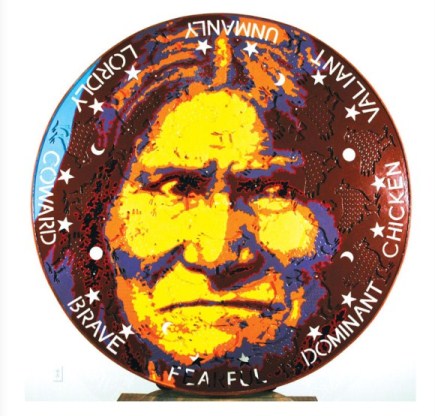
“I was born on the prairies where the wind blew free and there was nothing to break the light of the sun. I was born where there were no enclosures.” ~Geronimo
Wheel of Fortune by Bob Haozous
Yin and Yang
Shelli Carlisle
Respected and loved by his people, Geronimo became a great leader of the Apache. Born free, Geronimo would battle most of his life to live free. He spent many years in US Army Prison Camps along with other Apache warriors and their families. Kept from his family and sentenced to hard labor, Geronimo continued to lead his people spiritually. After years of containment, Geronimo was finally released to live his later years on the reservation—only to dream about running like the wind, once again, free.
Although Geronimo no longer walks this earth, his blood continues to inspire freedom via art throughout the world. His battle is now fought with paint brushes, carving tools, metal and plaster, books, and award winning documentaries. All utilizing the freedom of the mind and the pursuit of expression.
Two Brothers, One Heart
World renown artists, Phillip Haozous and Bob Haozous are the second generation of Chiricahua Apaches to be born in freedom. Their grandfather and his family were held prisoners by the U.S. government, along with Geronimo, for almost three decades. The injustice the family endured is remembered through the generations and is represented by the extraordinary art Phillip and Bob create. Although, they share the same legacy, it is apparent upon meeting them and/or seeing their art, these brothers are the anti-thesis of each other.
Phillip Haozous was born on a chilly December day in 1941 in Lawton, Okla. Two years later in sunny Los Angeles, Calif., Bob Haozous was born. Their father, Allan Houser, moved the family to Los Angeles during WWII to work in the shipyards. When the war ended a few years later the family moved to Utah, and the boys attended elementary school. Their parents found work at the Inter-Mountain Indian School, a boarding school for Navajo Children.
Award winning documentary film maker, Bryan Beasley said, “Allan taught art at a school in Utah during the 50s. They definitely got to see a lot of racism. They would be the only people that were not white and they were told over, and over again, that they were going to hell because they weren’t Mormon and they weren’t white. You can see how that would scar someone just from that aspect alone.”
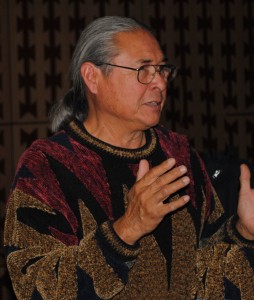
“I knew that there was something that I had inside me and I knew that I had a sense of design because of my flute making.” ~Phillip Haozous
Photographer ©Shelli Carlisle
Phillip Haozous
As a child Phillip recalls wonderful times rolling around on the floor with his dad, tickling and wrestling. He chuckles when he recalls going to restaurants where his father would create little orbs out of paper and make them flip and jump around the table—which would delight his family. Phillip loved to watch his father work.
Phillip said of his father, “As I grew up, I realized he could do anything he wanted to do. He was very talented.”
Phillip followed in his father’s athletic footsteps. His excellence in track and field earned him a scholarship to Utah State University. After college he hooked up with a theater group in Cripple Creek, Colo. It was here he began making authentic Indian jewelry for his costumes.
A few years later he left Colorado and enrolled in the prestigious Institute of American Indian Arts in Santa Fe, N.M. He was selected as the most outstanding jewelry student of his class, which inspired him to hone his craft.
Phillip’s love of music and the ability to play the flute sparked his interest to learn the age-old tradition of flute-making passed on by his grandfather, Sam Haozous. Eventually, Phillip’s work evolved into sculpting.
His art is a reflection of his calm nature. It is highly personalized and the emphasis is placed on human relationships.
His work is welcoming, sleek, refined. A mixture of modern and traditional, his creations draw you in; dares you to caress it’s lines with your gaze, pulling you into a safe place, a warm and secure space engaging all of your senses.
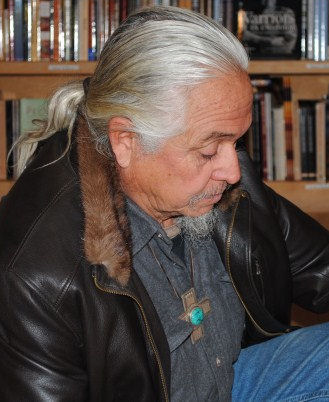
“I’m an artist because I have no choice, it’s just what I do. I love what I do.” ~Bob Haozous
Photographer ©Shelli Carlisle
Bob loved sitting on his grandfather’s lap while his grandfather told stories of their ancestors customs, shared their pain, and triumphs.
Bob said, “When I was in the first grade, the teacher told my parents that I was calling myself Haozous.”
The teacher said to his parents, “He has to be taught that he is a Houser.”
Bob said, “My parents sat me down and said you’re a Houser, you’re not a Haozous anymore.”
“After they were done, my grandfather took me into the back room, and said, you’ll always be a Haozous. That really had a profound effect on me,” said Bob.
After Bob finished high school in Utah, he joined the Navy. He served in Vietnam as a machinist’s mate. After his service he attended the College of Arts and Crafts in California and later moved to Santa Fe, N.M. where he built his home and studio.
Bob presents an emanation of power, discontent, and vigilance. This is the crux of his work. Although Bob seems aloof in public, his art is anything but that.
His in your face style is bold and brash. His work encompasses a myriad of textures and skills, for he works in wood, stone, aluminum, and steel.
The work shares the age-old story of the many injustices forced upon his family by using familiar symbols and infusing them into dauntless creations. They slap you in the face and demand that you recognize the unpardonable shame of the United States history.
The Inspired Brothers
Both Bob and Phillp’s work is influenced by the riches of the Apache tradition. Although, they are brothers and share the same love of art, their expression is distinctive, beautiful and powerful–each in its own way. Their art is an inspiration for all, to dig deep inside one’s self, explore, seek and find your own truth.
The Houser-Haozous story of courage and triumph inspired the award winning documentary Unconquered: Allan Houser and the Legacy of One Apache Family by first time documentary maker, Bryan Beasley.
Beasley said, “Even though they are very different, they’re both extraordinarily passionate about their art. They are both fascinating individuals, they’re just very very different. Which I think is great, you know, how boring would it be if they were exactly the same? Even though they’re not that far apart in age, they have different life extremes. Bob studied art in the 60’s in San Francisco. He was around for the whole Height Ashbury thing.”
Comparison and Contrast
It seems Geronimo is alive and well and expressing himself through his grand-nephews. The introspective, spiritual side of his personality resides in Phillip. The fractious, warrior side of Geronimo is expressed through Bob.
Beasley says, “Bob’s thing is he wants to provoke you, he wants to intimidate you, he really wants you to think about why am I looking at this. He loves his steel pieces. He has lots of automobiles and planes in them. I asked him why are there planes on this piece?”
Bob said, “The plane is like the one thing, no matter where you are in the world, they’re going to fly over you eventually. I was in the middle of the rainforest with indigenous people who had their own language. They had no technology and then I look up, and a plane is overhead. Someone’s going to Buenos Aires or somewhere, you can’t stop technology from moving forward. Here I am looking at these people that are stuck 100 years behind me and yet, the greatest invention is flying over their head, they couldn’t care less about it.”
Beasley said, “Phillip, he says he’s kind of carrying on with Allan’s vision, he’s more lyrical. What ‘s interesting about Phillip, is that when Allan was alive, he (Phillip) expressed his art through jewelry and flute making. He didn’t do any sculpture or painting. It wasn’t until his father passed away–we talked about him going into the studio after his dad passed away, and Allan had a piece of clay that he had been working on. And, Phillip literally started sculpting, right then and there. He made a little owl.”
And he said, “It wasn’t great, it was nothing I would really never want anyone to see, but it was a start. For me as a son, it was very emotional. My father was working with this exact clay, he was going to make something with it and time ran out. That I was able to make my first sculpture out of that, was something that I held special.”
Beasley continued, “Phillip has that little owl in his office. So, that was Phillip’s first thing. He started from there and now he makes these gigantic, huge pieces that are in museums. And that’s only been in the last decade. Which I think is a life lesson in itself, that you are never too old to do or try something new.”
[nivoslider slug="allan-houser-bob-and-phillip-haozous"]
Tagged Allan Houser, artists, Bob Haozous, Bryan Beasley, Native American Artists, Phillip Haozous


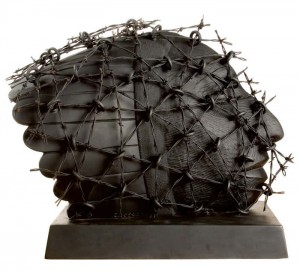
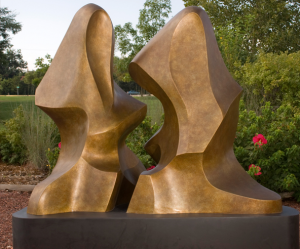
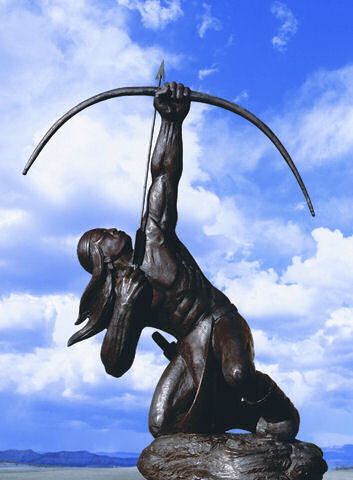
Allan Houser Teaching Spirits Unconquerable | Boomer Style MagazineNovember 10, 2012 at 4:26 am
[…] desired to create a haven for his art and his family. Together with his son, Phillip Haozous, they designed and constructed a unique fusion of art studios, family homes, dance grounds, […]
Oklahoma’s Stain Inspires a New Art Form for an Artist | Boomer Style MagazineNovember 7, 2012 at 4:00 am
[…] of One Apache Family, which is narrated by Val Kilmer. This inspiration led him to work with the Hazous brothers, two baby boomer artists whose talent was passed on to them by their father, world renown artist […]